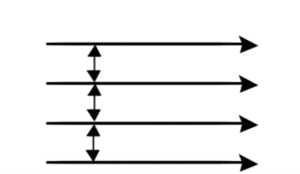In an electric field, the electric field lines or lines of electric force are imaginary lines whose tangent at every location indicates the direction of the electric field at that location. An electric field of a point charge, like every other electric field, is a vector field that indicates the effect the field of a point charge has on other charges in the area around it. The dependence of field lines determines the direction & strength of the electric field.
Principles of drawing Electric Field Patterns:
First Rule: Charged Objects Produce Stronger Electric Fields:
There are a lot of rules and regulations that must be followed while drawing such arrangements of electric field lines. The rules are simply in place to guarantee that electromagnetic field line arrangements transmit as much insight into the nature of the electromagnetic current around a charged item as feasible. Highly lines are frequently employed to encircle more charged objects. Stronger electric fields are created by objects with a higher charge. By surrounding a charged item with additional lines, the line density may be utilised to indicate the intensity of an electromagnetic current in the area surrounding it.
The concentration of lines surrounding any specific item offers information about the amount of charge on the origin charge as well as the strength of the field at that particular location in space. Take a glance at the right-hand item. Two separate circular cross-sections are formed at varying distances from the source charge. The areas of space near but far from the source charges are depicted in these cross-sections. The field lines are close together in the regions of space nearest to the charge, and they are wider apart in the regions of space at the furthest charge. point
Second Rule: Electric Field Lines Perpendicular To The Surface:
A second rule for creating electric field lines is to set the boundaries of force perpendicular to the levels of the components at the spots where the lines connect to the surfaces of the objects. An electric force element aligned close to the direction of symmetrically formed or irregular in shape objects is never present. The electrostatic force, and thus the electric force, has always been parallel to the surface of the item. If there was ever an element of force parallel to the surface, any surplus charge lying on the exterior of a supply charge would begin to accelerate.
Third Rule: Intersection of Lines
For planning electric field lines, the crossing of lines is a final rule. It’s never a good idea to cross electric field lines. This is especially important when drawing electric fields for situations requiring an arrangement of charges.
If electric field lines were ever permitted to connect at a precise spot, you may reasonably imagine what would happen. Electric field lines reveal the direction (and strength) of an electromagnetic current inside an area of space. If the lines intersect at a particular place, the electric field must have two separate values, within each unique direction. There was no way this was going to happen. Every point in the area has its own electromagnetic field, which is distinct in terms of strength and direction. As a consequence, the lines describing the field are unable to intersect at any point in space.
Properties of electric lines of force
- Electric field lines of force originate at a positive charge and end on a negative charge.
If there is only one positive charge, then lines start at a positive charge and end at the negative charge points. If there is only one negative charge, then lines start from and terminate at a negative charge.
- Two electric lines of force never intersect each other because there cannot be two directions of the net electric field at a single point.
- Electric lines of force produced by static charges do not form closed loops. If
- lines of force make a closed loop, then work done to move a +q charge along the loop will be non-zero. So it will not be a conservative field. So these types of lines of force are not possible in electrostatics.
- Qualitatively, the Number of lines per unit area (line density) is proportional to the magnitude of the electric field.
If lines are dense E will be more
If lines are rare E will be less and
If E=0, no electric line of force will be found there
- Number of lines originating(terminating) at a charge is proportional to the magnitude of the charge.
|q|Number of lines
- Electric lines of force end or start perpendicularly on the surface of a conductor.
- Electric lines of force never enter into conductors because the electric field inside the conductor is zero.
Conclusion
Electric field lines are a useful tool for seeing how electric fields appear. Michael Faraday first brought them together. As a consequence, the path of the electric field at any point relates to the tangent to the electric field line.
Second, the relative density of electric field lines around a spot is proportional to the relative intensity of the electric field relating to that position, which is quantified in magnitude. The electric force determines the dependence of field lines at any place. From the field of a point charge, the electric field spreads outward in all directions.
 Profile
Profile Settings
Settings Refer your friends
Refer your friends Sign out
Sign out







